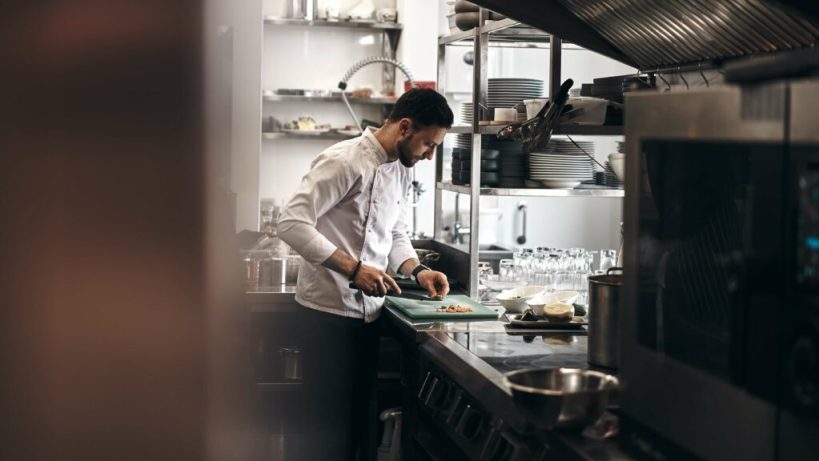Last Updated on by My Rasoi
Virtual Kitchen is a new concept, which has been growing in the foodservice industry at a very high pace. People often confuse Virtual kitchens with terms like ‘Ghost kitchen‘ and ‘Cloud Kitchen’. But, they are different, let us first understand each one of them:
- Virtual Restaurant is a new or present brick-and-mortar store. It delivers food online under various brand names. These units have both dine-in and takeaway as the mode of service. For example, Burger Inn, specializes in burgers, fries, and shakes and knows there’s a good market for pizzas as well. So they open a new brand by the name of Pizza Inn, using the resources and infrastructure of Burger Inn. Voila, now they have a new virtual kitchen.
- Ghost Kitchen is a kitchen that only delivers food with no brick and mortar store and with no dine-in option.
- Cloud Kitchen uses a commercial kitchen for the purpose of preparing food for delivery or takeout only, with no dine-in customers.

Opportunities and Benefits of Virtual Kitchens
In the last 4 years, the concept of a virtual kitchen is coming into the limelight. So, there’s a huge scope for early users.
The benefits of a virtual kitchen are notable. Some of which are:
- It’s going to save you a major chunk of your capital on a new location, machines & staff
- Management of staff, operational tools, and processes become easier. In other words, batch-prepping items make it simpler for the restaurant owner to run more than one brand too.
- Moreover, you get a chance to experiment with one brand without risk the image of other brands
During the COVID pandemic, the hesitance to go out for dining has given a huge boost to home delivery. Therefore, if you have the idea to create your own app. By providing offers home delivery services, you can save a lot on third-party commissions.
Besides these points, online delivery has given access to a wide spectrum of cuisines. The reason is, consumers are experimenting with their eating behavior. This gives the restaurant owners a great window of chance to take a risk and jump into this.
Reports say, 1 in every 4 restaurants is closed across the world. Thus, COVID forced most restaurants to fall off their operations to a great extent.

Case Study
An all-rounded brand in Chandigarh, India by the name of Food@U, runs a culinary school, barbeque catering service, and a host of virtual restaurants under an area of 20,000 sq feet kitchen.
Food@U operates 12 virtual restaurants all under the same roof!
If you’re feeling like having Indian food, Curry’s has you covered with a lot of delicious combos.
Rainy day? Order small bites from The Indian Street Food Co.
Cheat Day? Order a greasy burger and shake from Hardy’s Burger.
In the mood for Chinese? Little Beijing has you covered.
All of these cuisines come from the same Food@U kitchen. So, you get the idea right?
In other words, what Food@U has done is quite good. Instead of investing in dine-in facilities, they’ve invested in buying the latest machinery and technology. Thus, it helps serve a wide option of cuisines quickly. Food@U is not only a successful business but a one-stop shop for all things food for the customers of City Beautiful. They’ve laid out a plan for new and existing restaurant owners to do things a certain way post the pandemic.
Even online delivery services are investing heavily in Virtual Dining. Players like Swiggy and Zomato have invested millions of dollars in virtual concepts, and setting up a virtual kitchen is easier than one might imagine.
Instead of a huge space like Food@U, one can set up a virtual kitchen in a 250-300 sq. ft. room. Setting up a virtual restaurant is a familiar process if you’re an existing restaurant already delivering food. Just get in touch with your point of contact from the delivering service(s) and they’ll guide you through it since you’ve already given most of the documents required.
Documents you need to set up a Virtual Restaurant in India?
If you’re looking to set up a brand new virtual kitchen the process is fairly easy. You will need:
1) FSSAI Food Safety & Standards Authority License
2) Aadhar copy (for KYC)
3) Your Restaurant Menu
4) PAN card copy
5) Canceled Cheque
6) Bank Details
7) GSTIN (optional)
How My Rasoi innovates and connects with Virtual Kitchen?
My Rasoi is a time and cost-effective solution for new or existing virtual dining experiences. Instead of printing new physical menus, use My Rasoi for a hassle-free experience.
My Rasoi provides contactless menus for digital ordering that are a safer alternative to physical menus and has several benefits. Updating items in menus are just a few clicks away, which saves you a lot of cost and man-hours.
It’s vital to know your best sellers and position them on the top of your menu for increasing sales, which is made possible by the My Rasoi customer data and analytics center. Get the My Rasoi App and take your business online in just 15 seconds!

